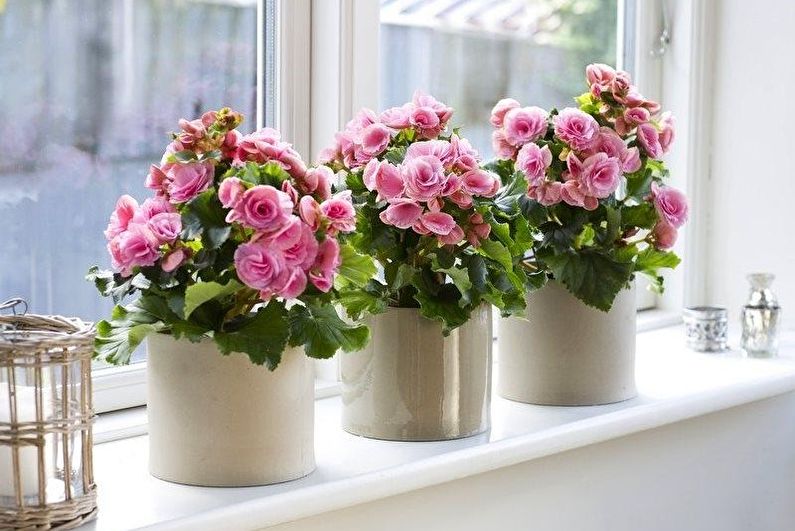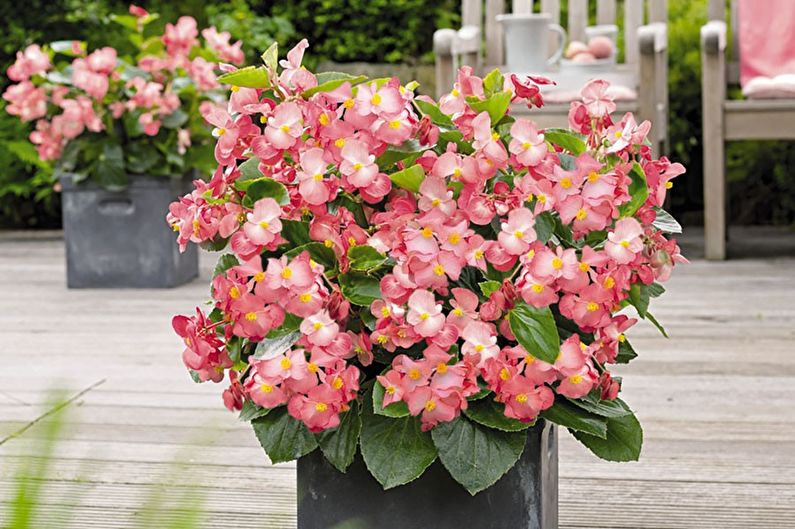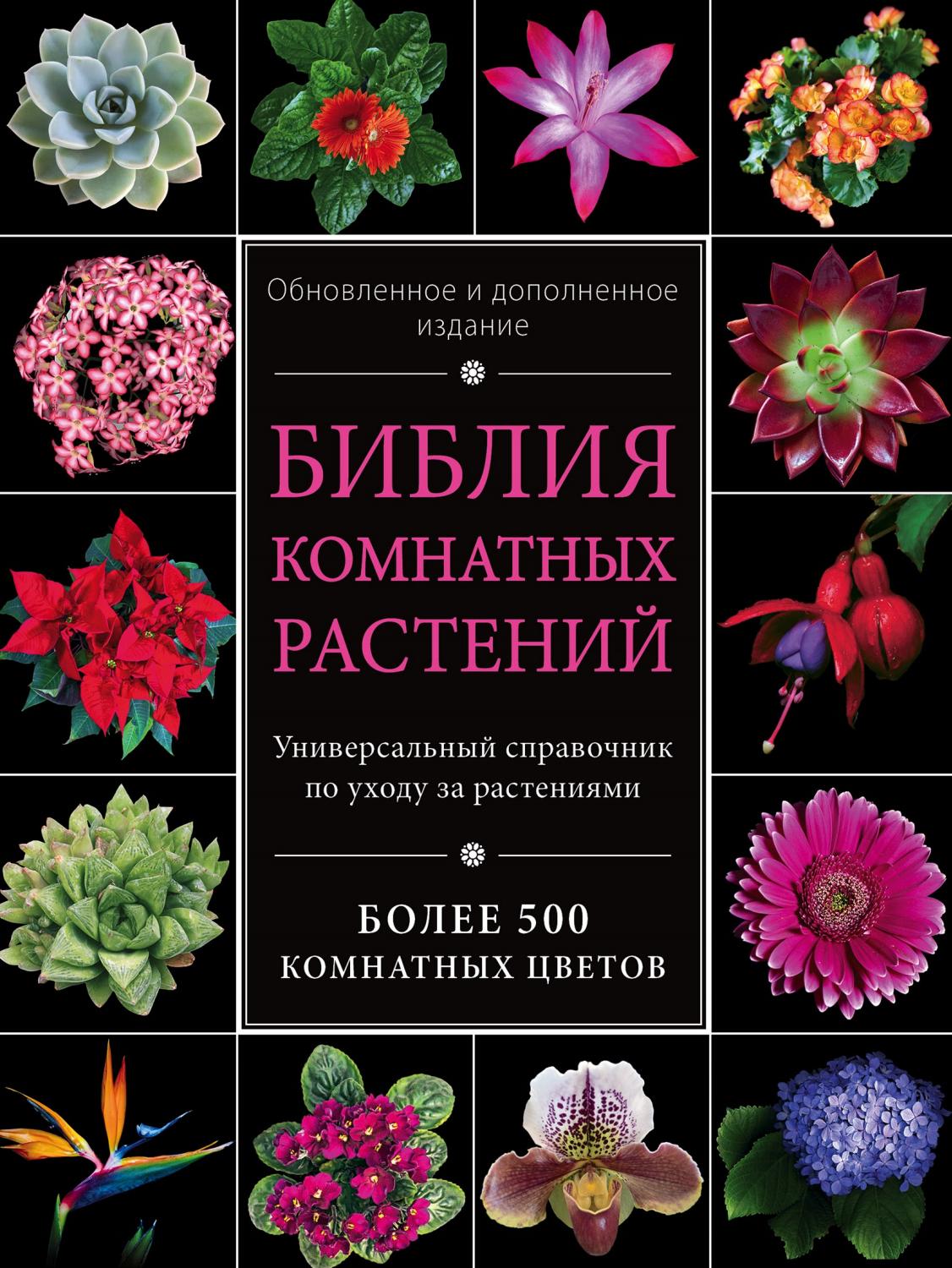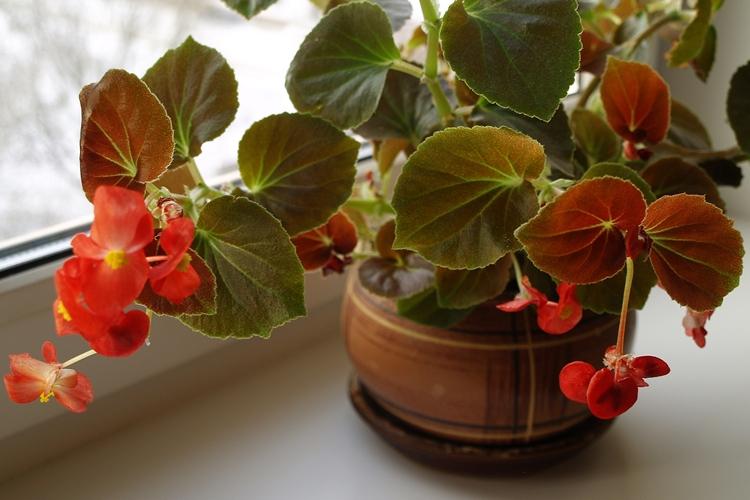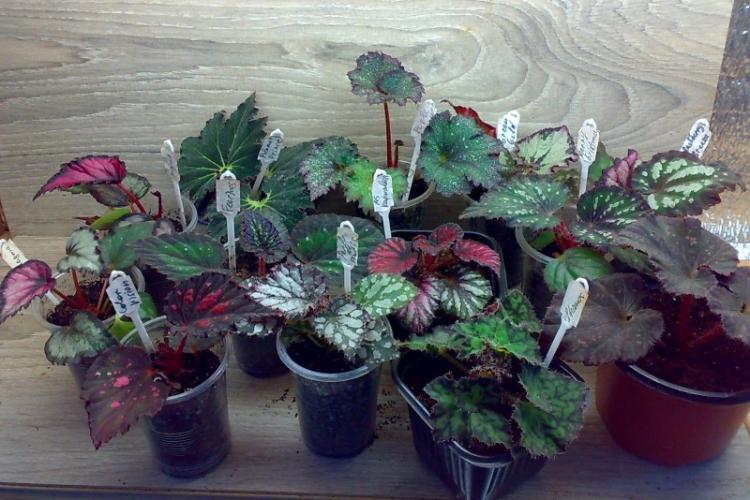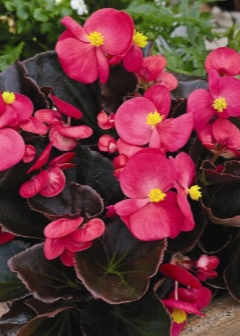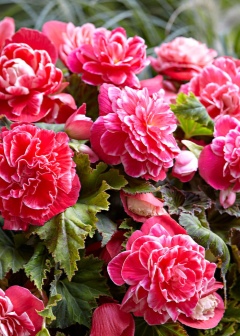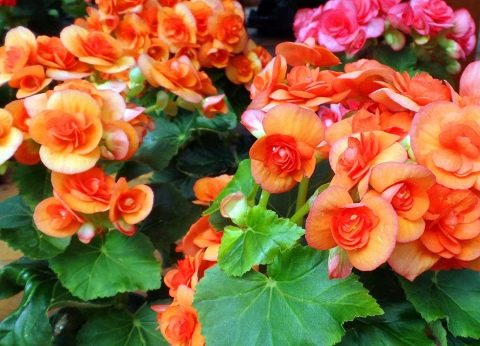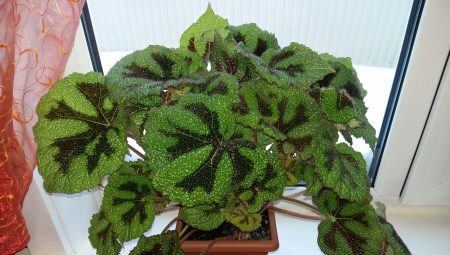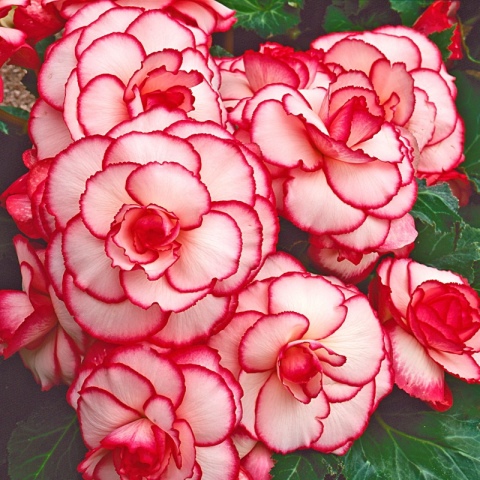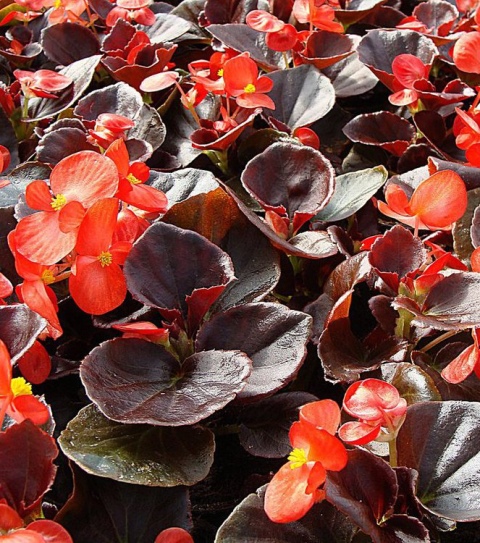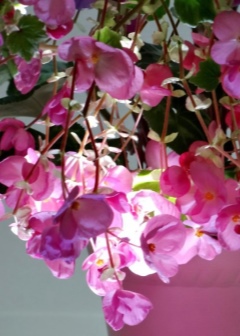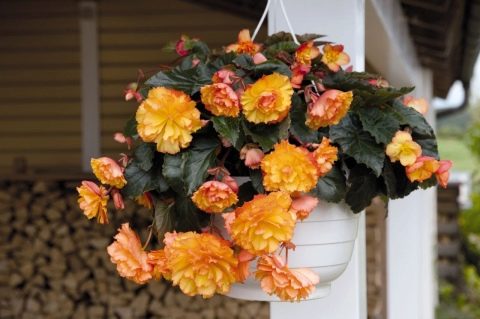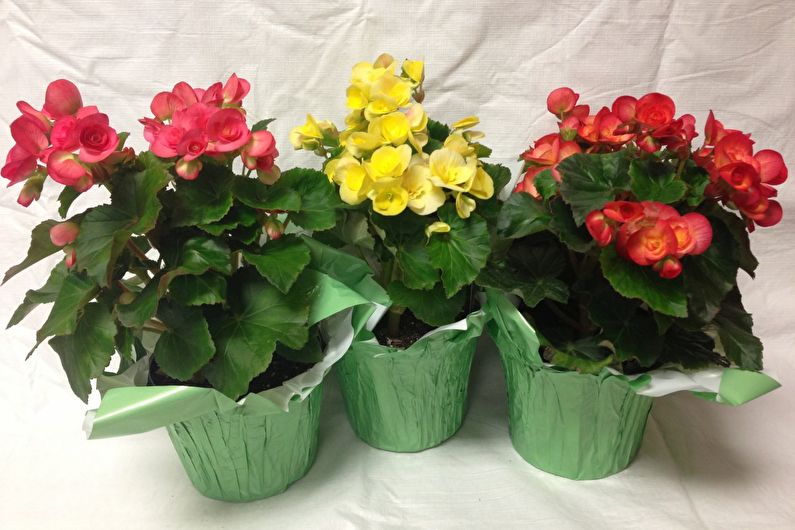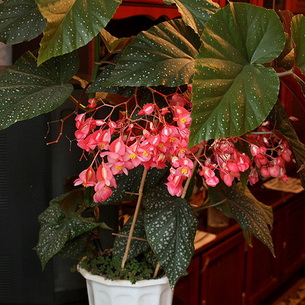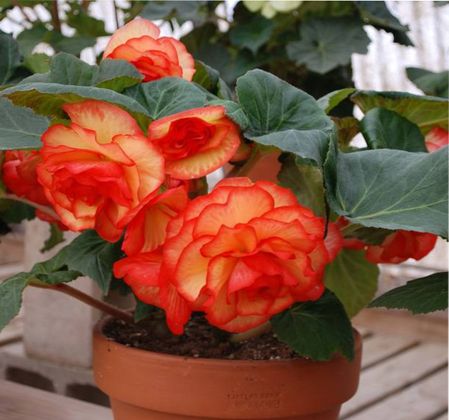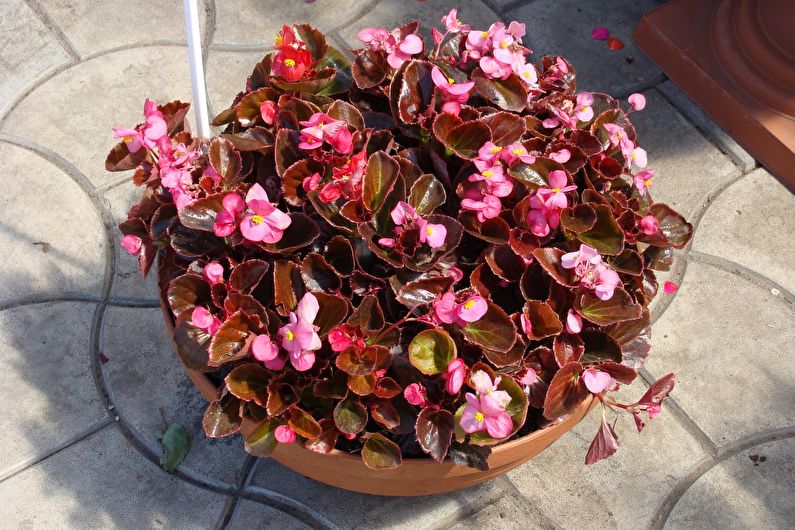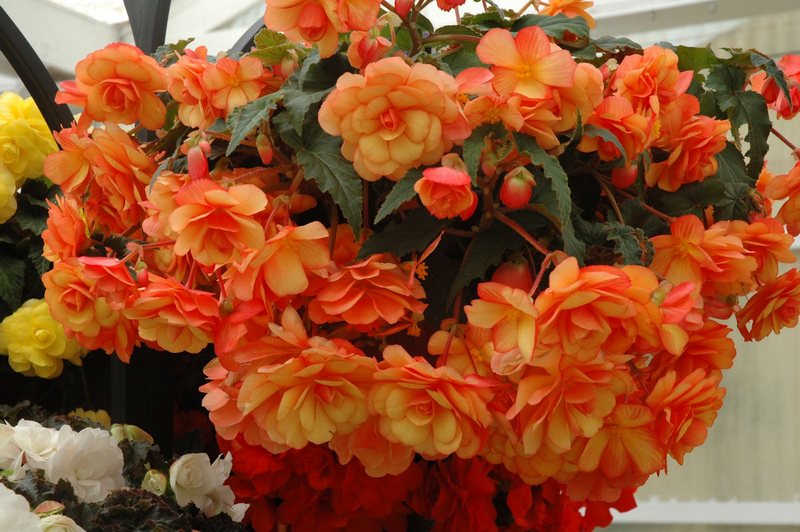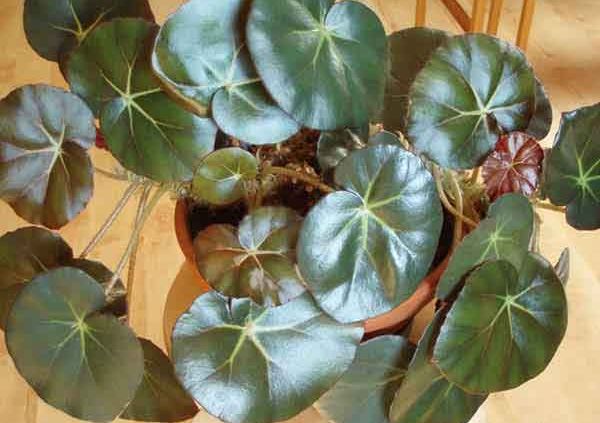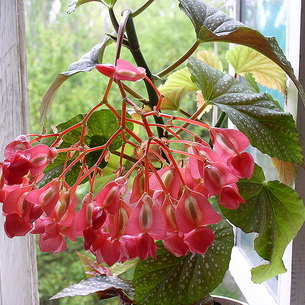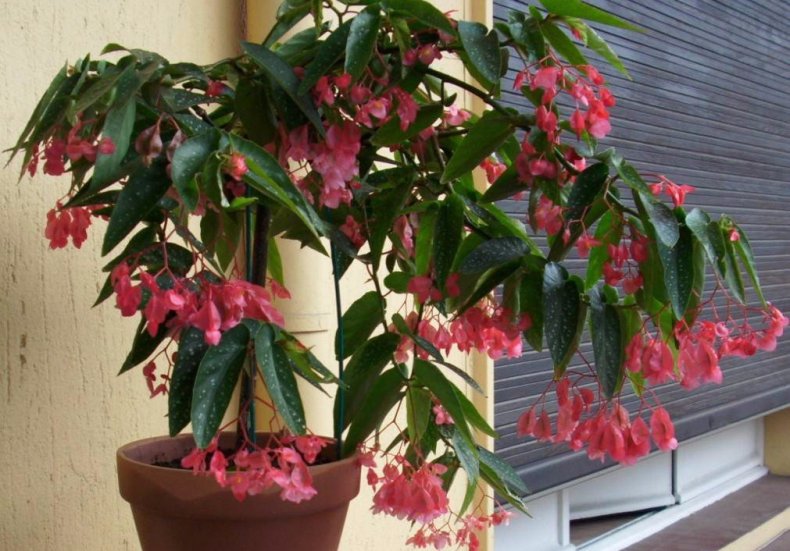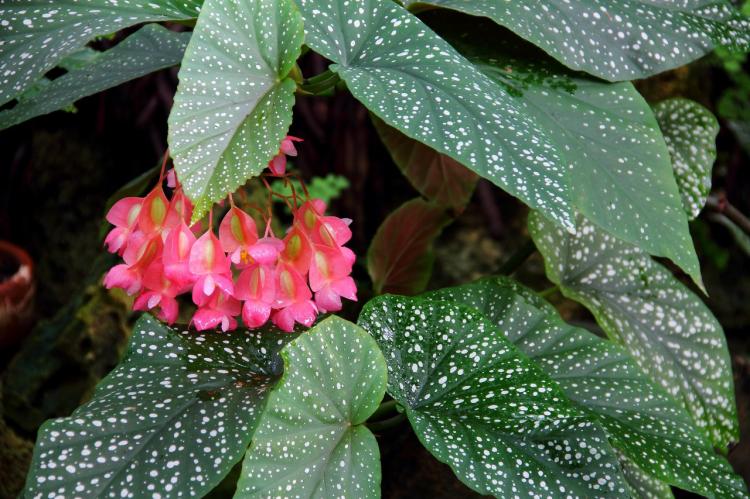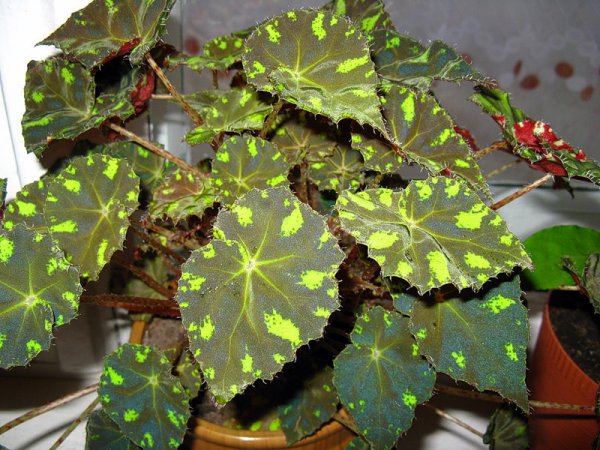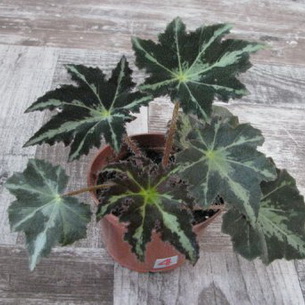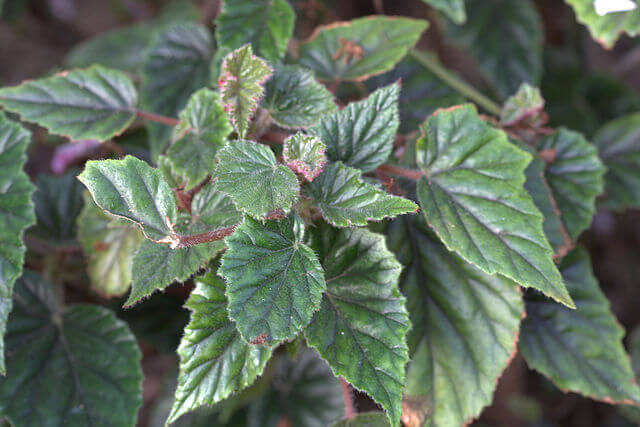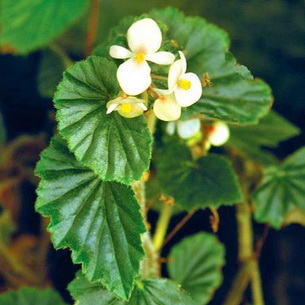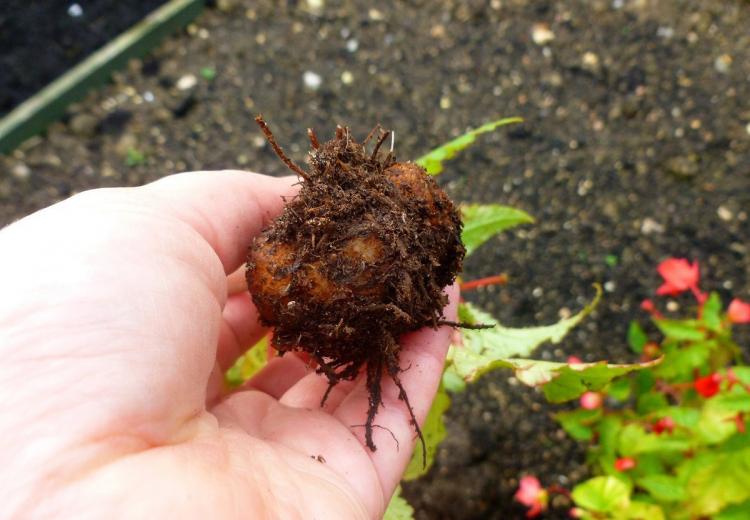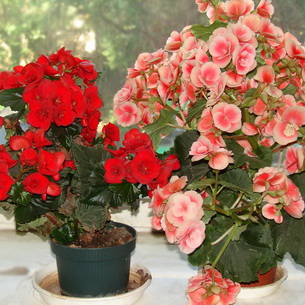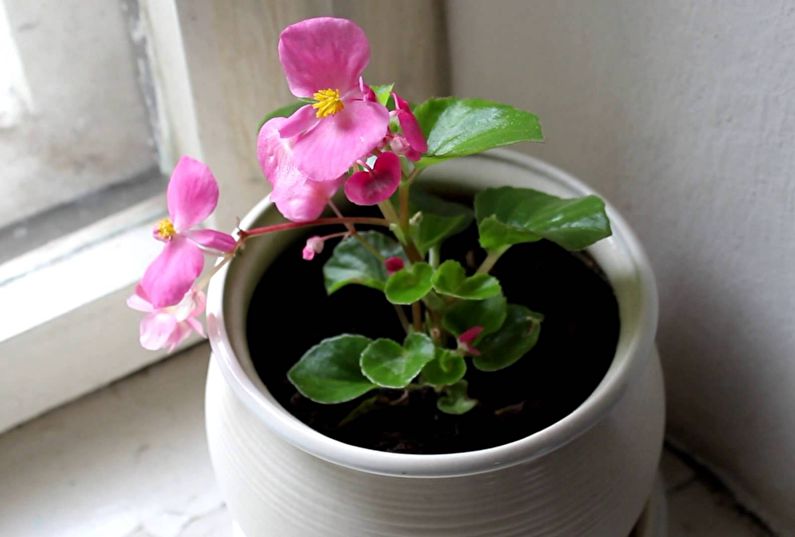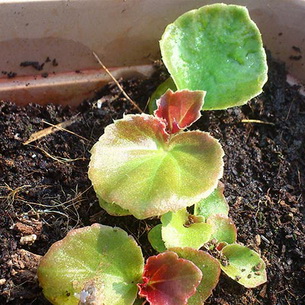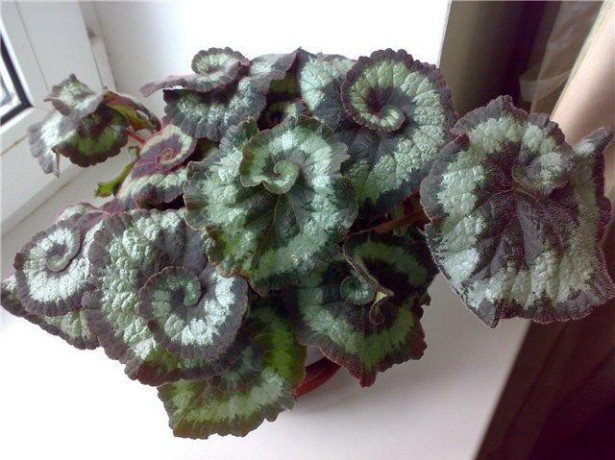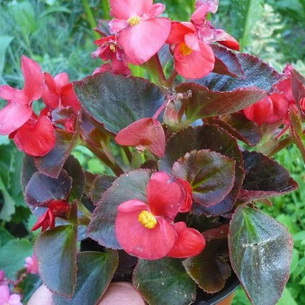Home begonia care
Flowers differ not only in appearance, but also in the requirements for growing conditions. Some varieties are more moody than others. But in order to grow a healthy and beautiful plant, you should definitely take care of it.
Lighting, humidity and temperature
Although begonia tolerates shade, it is not a shade-loving plant. At noon, it is advisable to shelter the bush from hot rays. In summer, it is better to move the flower with a pot away from the window, and in winter, on the contrary, move it closer to the light in order to ensure uniform annual illumination.
The air temperature should be moderate: 20-26 ° С in the daytime and not fall below 15-16 ° С at night. In winter, the plant does not need rest, so you should not change the temperature regime.
Soil and flower pot
The plant prefers a loose, moisture-permeable and nutritious soil with a slightly acidic reaction. For adult shrubs, the following composition is suitable: peat, sand, deciduous soil (1: 1: 3). The bottom of the pot must contain drainage.
Since the root system is shallow, the planting container should be wide, but not too shallow. If the plant is tuberous, then when planting, the distance from the edge of the pot to the tuber should be 3-4 cm.
Watering the plant
Water intended for irrigation must be prepared in advance. To get rid of chlorine, the water must be defended for at least a day, and to soften it, boil or use a filter.
Experts recommend watering the plant in the morning, preferably at the same time. The frequency of watering is determined depending on the conditions and drying out of the soil. In summer, the amount of water should be higher. To maintain a sufficient level of moisture, the topsoil should be loosened to a depth of 1 cm.
Top dressing of begonias in a pot
Once every 10 days, the flower needs feeding, while fertilizing it is desirable in the evening hours. Before starting feeding, the ground needs to be watered
In order to avoid toxicosis and death of the plant, it is important to ensure that there is no oversupply of fertilizers.
Bona Forte, Begonia, Good Power, purchased in a specialized store, are suitable as top dressing.
Timing and pruning rules
Pruning the plant is necessary both to get rid of old elements and to form a bush. Pruning rules:
- In a young individual (6 - 7 cm in height), the top should be cut off.
- Reduce watering frequency until the plant grows vigorously.
- When the shoots reach 10 centimeters in length, you need to cut off their tops.
- To preserve the crown, elongated branches should be removed.
How to care for begonia in winter
Each type of flower in the winter needs certain conditions. The most demanding is the tuberous type. Even after pruning, the soil should be periodically moistened so that it does not dry out. Bushy and decorative deciduous do not require special conditions.
Leafy begonias care
Decorative foliage begonia in home care is unpretentious. It must be watered, avoiding excessive drying out of the soil. At the same time, the plant does not need excessive dampness. In winter, make watering more moderate.
This plant does not tolerate spraying from a spray bottle at all. Even a slight ingress of water on the leaves during watering gives a change in their color.
Interesting! Top dressing is applied to the ground from March to November, it is better to take ready-made mixtures for begonias, today there are such compositions on sale.
It is quite simple to care for this plant: water, fertilize and keep away from direct sunlight. Transplant young plants once a year, older ones - once every couple of years, so that they grow better, and the soil does not deplete. If you take care and care of a flower, it will always delight you with beautiful lush leaves and a modest but charming flowering.
Reproduction
Mason's variety does not produce seeds, therefore reproduction is carried out by vegetative methods:
Tuber division
The procedure is carried out as follows:
- a part of 6-7 centimeters in size is separated, on which there is a kidney. It is she who will become the future plant,
- the cut is sprinkled with crushed ash and sent to wet soil or to a purchased peat-based substrate,
- the surface of the soil with the future plant is covered with polyethylene before rooting, sent to a bright and warm place,
- you need to drop in to begonias every 5-7 days. When young sprouts appear, remove the film and, if necessary, transplant the plant.
You can make the substrate yourself. It must be taken in equal shares:
- perlite,
- peat,
- sphagnum.
The purchased substrate must first be filled with water, and after 3-5 hours, drain the excess liquid. It is better if the base is wet rather than wet.
Leaf propagation
The emergence of shoots occurs after 14 - 21 days. The process consists of the following steps:
- prepare loose soil or substrate in a pot,
- a large leaf of a flower is separated with a knife, notches are made along its veins (veins),
- the leaf is laid on the soil and pressed to the surface. You can use a hairpin,
- cover the plant with polyethylene, put it in a bright place, but without direct sunlight. After the formation of shoots, we uncover Mason's new begonia.
Begonia care
Begonia is a flower that is easy to care for. To achieve its maximum lush flowering and active growth, you need to follow simple recommendations.
Lighting
The plant loves good lighting, but does not tolerate direct rays of the sun, the flower needs to be covered from them. The pot is best placed on the east or west side of the house.
From November to February, you can organize additional illumination using fluorescent phytolamps.
Temperature
A certain air temperature must be maintained in the room:
- in summer - 18-20 degrees;
- in winter - 12-15 degrees.
Watering
For irrigation, water is used at room temperature, previously settled for a day.
You need to water the flower correctly and regularly, avoiding excessive moisture in the soil. The exception is hot days when more moisture is required.
In winter, watering is carried out rarely and in moderation, and tuberous begonias can not be watered at all at this time.
Humidity
The optimum humidity level in the room where the begonia pot is located is 50%. To maintain this indicator at this level, you can:
- install a humidifier next to the plant;
- spray water, avoiding it falling on the leaves.
Top dressing
The plant needs regular feeding, it is carried out every 14 days from March to October. To do this, use:
- for decorative and flowering species - phosphorus-containing compositions;
- for deciduous varieties - nitrogen mixtures.
Transfer
The flower needs to be transplanted periodically. The regularity of this process is determined taking into account the type of culture:
- tuberous plants are transplanted annually in early spring;
- other varieties - when the roots become cramped in the pot.
For transplanting, you need to prepare the soil. To do this, mix:
- humus;
- leafy ground;
- peat.
First, a layer of drainage from expanded clay, pebbles with sand or perlite is laid out on the bottom of the pot. Crushed charcoal is poured on top with a layer of up to 3 cm, then filled with a fertile composition.
Begonia is watered abundantly, this will allow you to remove it from the old container without damaging the roots.After that, they are washed using a weak solution of potassium permanganate, damaged or dry processes are cut off.
The flower is placed in a new flowerpot, the free space is filled with soil and watered abundantly. For the adaptation period, which lasts about a month, the plant needs more moisture and protection from bright light.
Planting tubers in a container
At the end of February, the dormant period of tuberous begonias ends. This is clearly seen by the swelling and sprouting of the buds of adult begonias tubers and the awakening of small nodules that hibernated in their old pots (so as not to dry out). The best time for planting begonias tubers for germination is March - early April (depending on the readiness of the tuber and the time of its acquisition). There are tubers that wake up only in April.
First of all, you need to fill the shallow wide planting tanks with soil mixture. The main requirement for it is nutritional value and friability. Begonias thrive in a soil mixture composed of loose compost, peat and sand. It is advisable to add a little. We fill the pot not to the very top. Approximately 1/2 - 2/3 of its height or 7 - 8 cm below the top of the pot. After that, we compact the soil and spill it with a solution of complex fertilizers for flowering plants.
While the substrate is saturated with moisture, we have time to start preparing the tubers for planting. Begonia tubers are covered with remnants of old roots like a fur coat. The upper part can be recognized by dormant buds and traces from the stems of the previous year. If the buds are almost invisible, then the tuber is left in a bright place to speed up the appearance of eyes. There is one more way not to turn the tuber when planting "upside down". Its convex part should be in the ground, and the concave part on top.
Once again we inspect the tubers (they should not have any dubious flaws), after which we cleanse them of old roots and earth left over from last year. At the slightest suspicion, we disinfect the peeled tubers in a pink solution of potassium permanganate or use another option for sanitizing.
Some amateur flower growers plant tubers, which are soaked in clean warm water before that. Growth stimulants are sometimes used. They believe that this more actively awakens the tuber and accelerates the emergence of shoots. Unfortunately, such water procedures can result in tissue decay.
If there are a lot of tubers, then we select the best, strongest, youngest, with a diameter of 5 - 6 cm. The rest are planted "in reserve". Healthy large tubers can be divided into parts and further used as a full-fledged planting material. The main thing is to keep at least one viable kidney on them. To do this, they are pre-germinated in containers filled with a mixture of peat and sand. As soon as shoots begin to appear, the tubers are taken out and divided into several parts. The incisions are sprinkled with crushed activated carbon or treated with brilliant green. They are given the opportunity to dry out, leaving for a day in a dry room at room temperature.
It is worth mentioning about old tubers, the age of which is approaching the limit (by five to six years). They are larger (8 - 9 cm) and have many buds. During its life, the shape of the tuber has changed, it has become deformed, not even, but angular. Outgrowths have accumulated, traces of past shoots. It is better to divide such tubers into parts, waiting for the buds to swell in wet sphagnum or tissue.
After that, we lay out the tubers on the soil in the planting container. So that the kidneys and the entire top remain uncovered by the earth. Those. when planting tuberous begonias, we put the tuber on a moistened nutrient substrate, and then sprinkle it with soil mixture on all sides.
Ampel forms do not like crowding, so it is better to plant only one tuber per pot or hanging basket.When planting those tuberous begonias that will then be planted in a flower garden, you can use individual peat pots or other temporary containers with a diameter of about 10 - 12 cm. Planting boxes are also suitable. In them, the tubers are germinated, planting according to the scheme 7 x 7 cm or slightly denser.
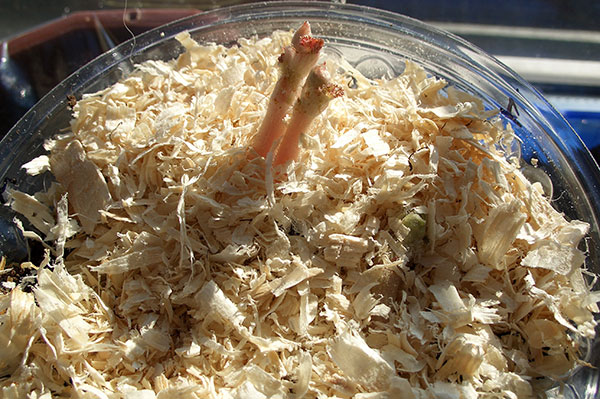
What does a begonia flower look like: plant characteristics
The begonia plant (Begonia) belongs to the Begonia family. Behind these words lies the richest and most diverse world, uniting about 1000 species of annual and perennial herbaceous plants, shrubs and dwarf shrubs, growing both terrestrial and epiphytic. The number of all kinds of hybrids and varieties, according to experts' estimates, exceeds several thousand. Thanks to this variety, begonias are popular in both gardening and indoor floriculture.
All kinds of begonia flowers are native to the tropical regions of both hemispheres. Named after the 17th century Governor of Tahiti, Michel Begon, a great lover and gatherer of flowers.
The first thing that should be noted when describing a begonia plant is the variety of forms: these can be shrubs (occasionally climbing), dwarf shrubs, and most often herbaceous plants with erect, creeping, sometimes ampelous shoots. The seeds of all begonias are extremely small. The fruit is a capsule.
A common characteristic of the begonia plant is the presence of succulent fleshy stems with asymmetrical leaves on the petioles, unisexual flowers, located 2-3 in the leaf axils. Luxurious flowering and decorative leaves made begonias very popular houseplants. When describing the flowers of begonias, they are conventionally divided into three groups, depending on the nature of the underground part of the plant: leafy, tuberous and bush.
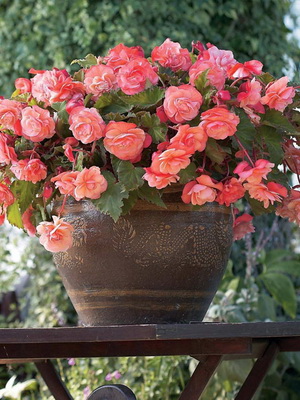
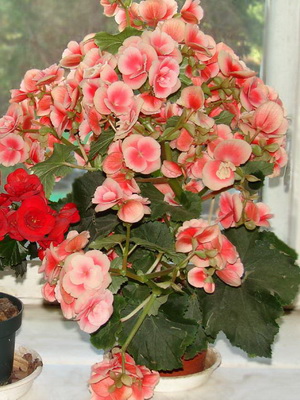
Blooming begonia is a wonderful decoration for a summer balcony or veranda.
Begonia has an interesting Russian name, indicating that this plant was widespread in Russia as early as 1812. During the flight of the French from Moscow, begonia was called "Napoleon's ear". Indeed, in outline and on the lower red side, the begonia leaf looks like a large frostbitten ear.
Decorative-leaved begonias naturally grow in the tropics and subtropics of Asia, Africa and America. Begonias are valued for their leaves of magical beauty - their ornament, unique color: from bright red with painting to brown, purple, silver-green. Flowers have no decorative value.
See what a begonia flower looks like in these photos:
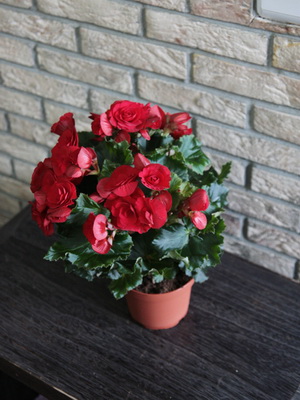
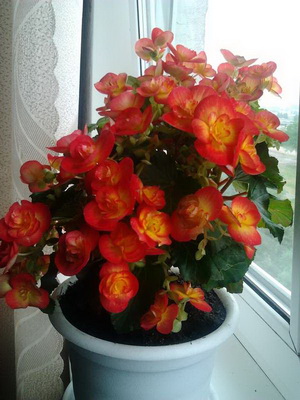
The flowers of many begonias are non-pollinated and do not produce seeds. Begonias should have died, but they cover many places in the rainforest with an almost continuous carpet. Let's take a closer look. Here beautiful leaves have fallen on moist soil. The delicate sheet does not dry out. The freshness of the leaf depends on the good wettability of the leaf surface, as well as the presence of aquiferous tissue in the leaf petiole (similar to the aquiferous tissue of succulents).
Further you can familiarize yourself with photos, names and descriptions of begonias of different types and varieties.


